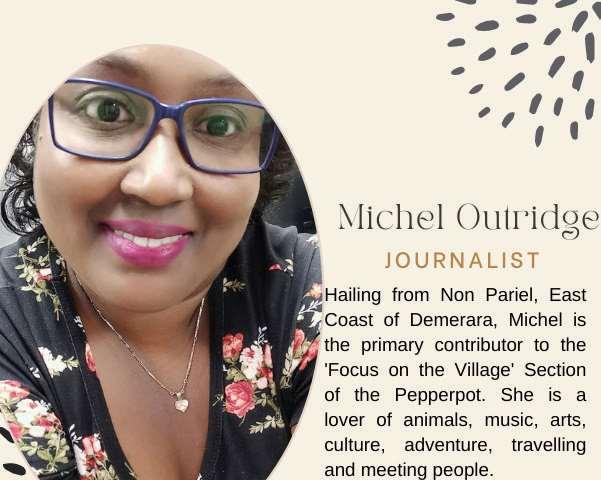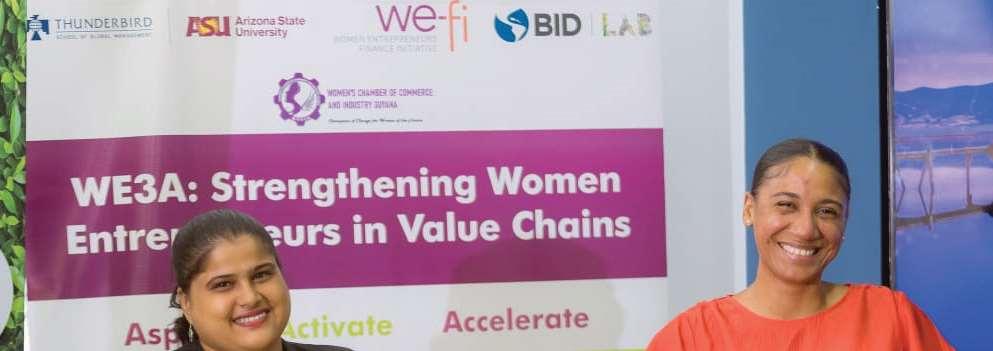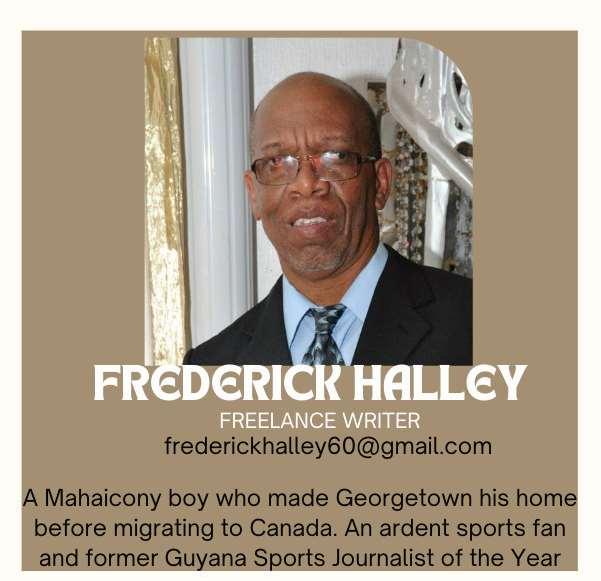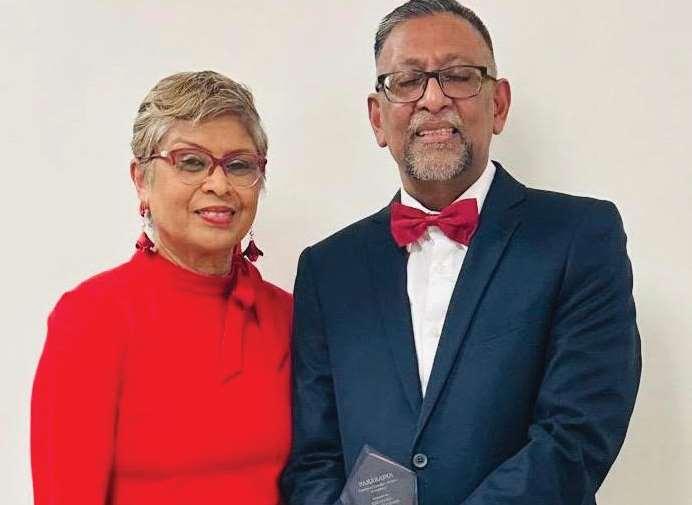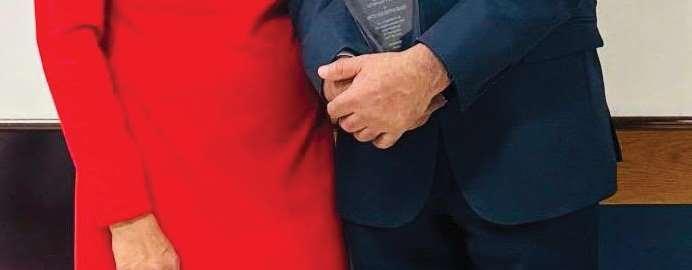PitchPerfect
INapowerfuldisplayofentrepreneurship,creativity, andingenuity,ninewomen competedinyetanotherof WE3A’simpactfulBusiness PitchCompetitions.Each participanthadjustfive minutestoconvinceapanel ofjudgesoftheirunique businessideas.Fromcar washesdesignedassafe spacesformumstogrocery storesinruralEssequibo, thecompetitionshowcased thediversityofideasand theenthusiasm,creativity, andambitionofthewomen behindthem.
Aspire,Activate,and Accelerate
TheWomen’sChamber ofCommerceandIndustry Guyana(WCCIG)partnered withtheInter-AmericanDevelopmentBank(IDB)and ThunderbirdSchoolofGlobalManagementtobringthe WE3A:StrengtheningWomenEntrepreneursinValue ChainsProjecttoGuyana. Thisprojectisfundedbythe IDBLabandWeFi.Nowin itsthirdyear,theinitiative willcontinueinto2025.
Oneofthemanydriving forcesbehindtheinitiativeis accomplishedbusinesswoman,entrepreneur,andauthor, TashiBrowne.“Thisproject,WE3A,isaboutAspire, Activate,andAccelerate,” Tashiexplained.“It’sathreeyearinitiativefundedby IDBandWeFi.Thefocus isonbuildingthecapacity ofwomenentrepreneursin LatinAmericaandtheCaribbean.Guyanaistheonly English-speakingcountry involved,”sheshared.
Thecompetitionreceivedrobustsupportfrom sponsorssuchasEnet,Sears ConsultancyInc.,Leadto theMinistryofHealth,and theGuyanaPayroll,allcontributingtovariouscash prizes.
Theprogrammestands outbecauseittargetsareasthatotherinitiatives oftenoverlook.TheAspire phasefocusesonstorytelling,helpingwomenseetheir potentialthroughtheexperiencesofothers.“The Aspirecomponentfocuses onstorytelling.It’sabout sharinginspirationalstories ofwomenwhohavealready succeededinbusiness.These storiesempowerotherwomenwhoarejuststartingout byshowingthemthatsuccess
ispossible,”Tashisaid.
TheActivatephaseshifts focustopracticalskills.Participantslearntobuilda strongfoundationfortheir businesses.“Activatetargets womenwhoareeithernew tobusiness—maybethey’ve startedwithinthelastthree months—orthosewhohave abusinessideabutdon’t knowwheretostart.The programmehelpsthemwith thefoundation,likepreparing abusinessplan,identifying theirtargetmarket,pricing theirproducts,andmarketing
Finally,theAccelerate phaseconnectsseasoned
International,whichhelps women-ownedbusinesses enterglobalsupplychains,” sheadded.
ThePitchCompetition
Thepitchcompetition isakeyfeatureofWE3A,
showcasetheirbusinesses. “Thewomenwhograduate fromtheActivateaspectcan participateinapitchcompetitiontodeveloptheirskills. Pitchingissoimportantbecauseyouneverknowwhen youmighthavetheopportunitytosecureaninvestment,”
family.Sheadmittedthatthe growthopportunity.“This eventwasaneye-openerin thesensethatIamnotthe kindofpersonwhowoulddo apitchinfrontofpeopleand presentinformation.NowI cantakemybusinesstothe nextlevelbecauseIhave
sharedherexcitement.“Iam reallyexcitedbecauseIhave
shared.
andglobaltrends,thatwill helpmeinthefuture,”she said.
andcapacity
entrepreneurswithopportunitiestoscaletheirbusinessesinternationally.“The Acceleratecomponentisfor womenwhohavebeenin businessforover10years andarereadytoexpandinternationally.Throughthisprogramme,they’reconnected withinternationalinvestors andcertifiedbyReconnect
Tashiexplained. Theeventfeatureda packedpanelofjudges,includingsomeofGuyana’s bestbusinesscoachesand entrepreneurs.
Thefirst-placewinner, StacyReeceofEastGate Products,manufacturestraditionalmarinatingsauces passeddownthroughher
Second-placewinner ReshmaTickchand,ownerof TripleRGrocery,explained herpassionfordelivering groceriestowomeninRegionTwo’sruralareas,which sparkedherbusiness.With herwinnings,shehopesto expand.“Ourbusinessisina ruralareawithpeoplelivingedtheopportunitytoreach us.Thisbusinessisbreaking abarrier,”shesaid.
Third-placewinner,LeshaunWrightPhilander,the visionarybehindPhilander’s Carwash—amobilecarwash andsafespaceformums—
neverreallypitchedbefore.I gainedalotofinsightintothe areasthatIcanimprovemy businessbecauseIwasgiven alotoftips,”shesaid.
Fourth-placewinner RonekaSam,founderof BakedbyNadia,earnedrecognitionforherhealthywatermelonfruitcakes.She acknowledgedthevalueof competitioninpreparingher forthefuture.“Thiswasmy whattopresentnexttimeand whatthejudgeslookfor.In
Tashiemphasisedtheprogramme’suniquedelivery method,whichmakeslearningrelatableandengaging. “Oneoftheuniqueaspectsof theprogrammeisthewayit’s delivered.It’snotjustabout reading;it’sananimatedstorytellingexperience.There’s acharacternamedAlmawho representstheparticipants. Alma’sjourneymirrorstheir own,makingthelearning processrelatableandengaging.Throughouttheprogramme,participantsbuild theirownbusinessplansstep bystep,andbytheend,they haveacompletedocument readyforuse.”
Thecompetitionsought tochallengeparticipantswith simulatedreal-worldscenarioswhereentrepreneurs mustcommunicateeffectivelywithinverylimited timeframes.“We’relookingforreal-worldsolutions here.Duringthecompetition, participantshavejustfive minutestopitchtheirbusiness—likeSharkTank.This isdesignedtopreparethem
ByMichelOutridge
DWRIGHTWardisapassionateyouthadvocatewhohails fromBuxton,EastCoastDemerara.Herecentlygraduated withaBachelor’sDegreeinInternationalRelationsanda DiplomainCommunicationStudiesfromtheUniversity ofGuyana(UG).Wardhasrecentlybeenhonouredwith theprestigiousIgniteCaribbean30Under30Caribbean ChangemakersAward,recognisinghisoutstandingcontributionstoyouthdevelopment.
Asaprominentmemberofseveralyouthorganisations regionally.Hisleadershipandadvocacyhavealsotakenhim tothe7thAnnualCaribbeanYouthLeaderSummit,wherehe representedGuyanaonaninternationalstage.
Ward’sjourneyinadvocacybeganatatenderage,driven byanaturalinclinationtohelpothers,particularlythosefacing
hasbeenevidentthroughouthislife.
Lookingforward,Wardaspirestobecomeadiplomat, favouritequotebyOliverHolmesencapsulateshisapproach tolifeandwork:“Everycallingisgreatoncegreatlypursued.”
WardtoldthePepperpotMagazinethathealsocompleted hisfour-yeardegreeinjust21/3yearswhilejugglingshift
Heisinvolvedinseveralyouthorganisations,suchasYouth Rise,whereheservesasPresidentandtheUSEmbassyYouth ActionNetwork,whereheservesasEventCoordinator.Healso holdsmembershipswithJCIGuyana,GuyanaNationalYouth CouncilandLeoClubRuimveldt.
“I’vealwaysknownthatmypurposeforlivingistohelp aperfectavenuetochannelthosechangeswhereIcanhavea
platformtoimpactlivesinseveralways,”hesaid.
WardattendstheLifeSpringMinistryandisabeliever inthepowerofmanifestation,notingthatwithoutGod, noneofhisachievementswouldhavebeenpossible.
“I’minthesteppingstonethatIbelievewillgetmetotendant,thencontinuemyprofessionalbackgroundinlater
diplomat,”hesaid.
Wardaddedthatheisdeeplyfocusedonyouth development,andnothingelsehaseverappealedto himasmuchasbuildingthefuturefortheyouthof tomorrow.Thisgoal,hesaid,ishiswayofcontributing tothecommunity.
“WhatIdoisreachouttoyoungboysorgirlsinthe communityandprovideguidanceforthemasitrelates tocareerpaths,thenextstepforward,orsecuringajob. I’veassistedpeopleinmyvillagewithemployment,skills training,ortertiaryeducation,”Wardsaid.
WardpointedoutthatheevenpartneredwiththeBoardstallationclassesintheafternoonforBuxtonianssothat hecamefromhumblebeginningsandthatbeingaresident ofBuxtonnevercausedhimtofeelhecouldnotachieve greatthingsinlife.
Wardisfromagroundedfamilywithbothparentsand twobrothers,oneofwhomholdsaBachelor’sDegreeinmunicationStudies.WardhasalreadysignedupforUrban PolicyandLeadershipstudiesatHunterCollegeinNew Yorkandwillcontinuestrivingforhighereducationto fromBuxton,hefacedstigmaattachedtothevillagedue toitspast,butthisyear,30villagersgraduatedfromUG.
Wardaddedthathewasneverbotheredbystigma becausehewasalwaysfocusedonbeingsuccessfuland
“Beingmulti-talentedandbeingabletoqualifymyself throughstudiesbringsmejoybecauseIknowitmeansa betterfutureformyself.Iwillneverstopbeingoverzealous inpursuinghighereducation,”hesaid.
Ward,whoisacitizenofAntigua,wasarecipient oftheAntiguaandBarbudaPrimeMinister’sScholarship,whichfullyfundedhisentireacademicjourney atUG.
DwrightWard
ONNovember23,EmpoweredFemGuyana,Barrelsof Love,InsideOut,andMother’sUnion-Guyanaexecuted theGloGirlCampattheVryman’sErvenSecondary School.Thisinitiativeaimedtoempoweradolescentgirls atVryman’sErvenSecondarytoaddressandovercome gender-basedbarriersbyprovidingthemwithtoolsand knowledgetoimprovedecision-making,pursueopportunities,andenhancetheiroverallhealthandwell-being.
Theeventsawfullparticipationfromallthegirlscatered for.Atotalof40girlsfromgrades8–10(ages12–15)were selectedthroughassessmentsdonebytheschool’sguidancecounsellor,RaquelWade,andheadteacher,Shaundel Phillips.
TheimpactfulsessionswerefacilitatedbyDenica Henry,MarissaFoster,SeetaDalloo,YvonneBarrow, StephaniePersaud,andAdeleMinty.Thefacilitatorsencouragedtheparticipantstospeakupandsupporteach otherincreatingasafer,morerespectfulcommunity. Theywereinspiredtobecomerolemodelsandpositive voicesforchangeagainstgender-basedviolence(GBV) intheirschoolsandcommunities.
AccordingtoSeetaDalloo,asocialworkerandco-founderofEmpoweredFem,“Itwasagreatexperience,andit’s alwaysapleasuretoworkwithyounggirls,especiallywhen they’reatanimpressionableagewhereguidanceisimportant.Thehighlightofthesessionswasseeingthegirlsbeing responsivetotheinformationshared,”shesaid.“Theirengagementwiththecontentwasveryencouraging,anditwas greattoseethemformtheirownopinionsonvarioustopics.I alsobelievemoreprogrammesliketheseshouldbeavailable forothergirlsinGuyanabecauseit’simportanttocreateaccesstoinformation-sharingandasafeempowermentspace.”
StephaniePersaudfrom501c3BarrelsofLoveInt. (USA)andYvonneBarrowfromInsideOutcollaboratedwithEmpoweredFemonthisinitiativeforgirlsin Berbice.EmpoweredFem,asalocalgroupfamiliarwith theneedforaprojectatVryman’sErvenSecondary, recommendedtheschoolandtargetaudienceandfacilicreatedGloGirl.
YvonnemanagedmostoftheprojectlogisticsandsecuredfundingsupportfromtheMother’sUnionofGuyana. resources,stationery,andotherthoughtfulgiftsforthegirls. Theprogrammecoveredtopicssuchas:
•UnderstandingGender-BasedViolence
•MentalHealthCoping Skills
•BuildingHealthyRelationshipsandBoundaries
•PurposeFindingand Self-EsteemBuilding
•GirlsasLeadersand ChangemakersAgainstGBV
Thegirlsalsolearnedan empowermentpledgeledby YvonneBarrow,withthehope ofinspiringthemtosharetheir experiencesandknowledge withotherclassmates.Through interactivesessionssuchas role-playingandscenariodiscussions,thegirlsengaged deeplywiththetopics.
InobservanceofInternationalDayfortheElimination ofViolenceAgainstWomen,a real-lifestoryofGBVinGuyanawasanalysedbyMarissa Fosterandthestudents.This
sessionfosteredmeaningful dialogueandaction-oriented solutions.
YvonneBarrowshared, “GloGirl1.0highlighteda groupfullofjoyandsomuch potential.Theirrichlaughter mixedwithquestionsofthe uncertainisproofthatour girlsneedusasmuchaswe needthem.”
TheparticipantsofGloGirlalongsidemembersofEmpoweredFem,InsideOut,Mother’sUnion-GuyanaandteachersofVryman’sErvenSecondary (MarissaFosterphotos) ThefoundersofGloGirl(Fromleft:YvonneBar-
Theteamisplanning asecondphaseoftheprogrammeforearlynextyear. Participantswelcomedthe GloGirlInitiativeandprovidedsuggestionsforfuture topics,suchaspoverty.The partnersaimtoexpandthis initiativetoothercommunitiesacrossGuyanaand welcomesupportfromlocal groupsandorganisationsfor futurecollaborations.
SomeofthecollaboratingpartnersofGloGirl.(Fromleft:YvonneBarrow, DenicaHenry,ShaundelPhillips,MarissaFoster,SeetaDalloo).
GUYANESE-BORNauthor,RichardRupnarain, isthelatestrecipientofthe PakaraimaLiteraryAward. Hewasbestowedwiththe prestigiousawardatlast Sunday’sPakaraimaWritersChristmasSocial,held inScarborough,Toronto, Canada.
Theawardrecogniseshis manyliterarycontributions. Rupnarainwasafounding memberofthePakaraima WritersAssociation,establishedin2005byJanet Naidu—poet,writer,and communityleader—wherehe servedasvicepresidentinits earlyyears.
InhisacceptancereontheformationoftheWriters’Groupandthestruggles writersfacedtogettheir workspublishedandrec-
ognised.Herecountedhow limitedinformation,includ-
ingresourceslikeAmazon, madeitchallengingforau-
thorstotakethenextstepin publishing. Rupnarainbeganhisliteraryjourneybywriting shortstoriesandplaysand
degreeinTheologicalStudiesatTyndale UniversityinToronto. Hewasordainedas apastorin1986and attheChurchofGod
in1994.Whilestudying,he continuedtowrite,focusing
lifeinGuyana.Manyofhis workshavebeenpublished inmagazinesandbooks. Notabletitlesinclude“A Ring,ARose,andaPair ofShoes–SkitsandPlays forAllOccasions,Vol.3”, “GuyaneseNights–Tales fromtheDiaspora,Vol.3”, “ChokeandRob:Talesfrom theDiaspora,Vol.5”,and hislatestnovel,“Susanna: UnsungHeroineofthe1823 DemeraraSlaveRebellion.”
GrowingupinthePresbyterianChurch,Richard wasinspiredtowriteonreligiousthemes.Todate,hehas publishedaround120books ontheology,prophecy,devotionals,andpersonalgrowth. Titlesinclude“HandwritingontheWall:Studieson Daniel1-6”,“ThePursuit ofExcellence:Meditations onthePowerofRighteousness”,“LivewithPrecision: WalkinginStepwithGod’s PlanforYourLife”,and “MySacredDuty.”Richard attendedQueen’sCollege inGuyanaandlaterstudied accounting.Heworkedasan accountantbeforeretiringto takeupafull-timepastorate inMississauga,Ontario.
In1987,afterimmigratingtoCanada,Rupnarain pursuedbiblicaleducation. HeearnedtheAssemblies ofGod(AOG)MinisterialDiplomaandaMaster’s
LisaFreemantle,poet, writer,andcomposer,isthe newPresidentofthePakaraimaWritersAssociation.She chairedtheprogrammefor theafternoon’scelebration andsharedreadingsfromher poetrycollection.
JanetNaidupresentedthe awardtoRupnarain,expressingherhonouratrecognising Naidusharedherlatestbook ofpoems,RiverCrossing, whileotherauthors,includingPeterJailallandKenneth Puddicombe,readfromtheir publishedworks.
(Canada)in1987. Rupnarainexpressed deepgratitudefortheaward, bythePakaraimagroup.PreviousrecipientsincludeIan McDonald(poetandwriter), RamabaiEspinet(professor, poet,andwriter),PeterJailall (poetandeducator),andJanetNaidu(poet,educator,and communityleader).
Theeventalsofeatured presentationsbyLalBalkaranonGuyaneseauthors ShirleyNajhram,achildren’sbookauthor,who showcasedherworksat thebooktable.Thecelebrationconcludedwith refreshments,networking,andcongratulationsto Rupnarain,whodelivered anengagingaccountofhis writingjourney.Hewas accompaniedbyhiswife, Sandra,ExecutiveDirectorofFamilyServiceof Peel,Brampton,andtheir twochildren,Stevenand Kimberly,andthreegrandchildren.
Rupnarain,duringhisacceptanceremarks
RichardRupnarainandwifeSandra
RichardRupnaraincollectstheawardfromJanet Naidu
Singlemotheranduniversitygraduateshareshowsheturnedlife’s challengesintosteppingstonesforsuccess
“THEskyisnever yourlimit,andnever settleforless,”says AnastaciaPereira.The 24-year-oldmother andteacherisarecent universitygraduate withaninspiringstory.Bornandraised byasinglemotherin Georgetown,Anastaciawasnotalwaysas passionateabouteducationassheistoday. Herchildhoodand universityyearswere filledwithnumerous challenges.Afterthe lossofalovedone andbecomingasinglemother,Anastacia usedherchallengesto fuelhersuccess,never lettinghurdlesstop herfromachievingher dreams.
“Growingup,I wasn’talwaysthemost inclinedwithmybooks, butmymotherbelieved inme.She’dbuyme bookseveryChristmas, pushingmetokeep learning.Ifounditboringatthetime,butlookingback,Irealiseshe sawmypotentiallong beforeIdid,”Anastacia saidtothePepperpot Magazineduringaninterview.
Anastaciasaysshe owesmuchofhersuccesstohermother,whorecognisedherpotentialeven beforeshefullyembracedit herself.Astheyoungestof fourchildren,shegrewup inahouseholdwhereacademicswerevalued,though shewasn’tinitiallydrawn toherstudies.Thischanged assheenteredhighschool, however.“Myjourneyreally startedinthoseearlydays.I maynothavebeenthetop student,butthattimeplantedtheseedofresiliencein torealisethatit’snotwhere youcomefromthatmatters; it’swhereyou’regoing,”said Anastacia.
Hermother’spersistent encouragement,especially throughgiftingbooksand urginghertofocus,laidthe foundationforAnastacia’s educationaljourney.
Later,attendingKingston Secondary,shegradually begantorealiseherown capabilities,supportedand
AnastaciaPereira(JaphethSavoryphoto)
encouragedbyteachersand mentorswhobelievedin herpotential.“I’llalwaysbe gratefulfortheteacherswho encouragedme.Theysaw whatIwascapableofand pushedmetobebetter,tobe thebestversionofmyself. It’sbecauseofthemthatI learnedtobelieveinmyself, evenwhenIdidn’tseethe wayforward,”shesaid.
Anastacia’sprofound faithwouldbetestedasshe beganhertimeatuniversity.
AnastaciaworkedwhilepursuingherBachelor’sDegree inInternationalRelations. Life,however,broughtunforeseentrials.Afterbecomingamotherat20andthe
Anastaciasaidherlifetook onnewchallenges.
“Duringmysecondyear atUG,everythingseemed tohappenatonce.Ilostmytherpassedaway,andIwas
stilltryingtokeepupwith mystudies.ItwasatimeI’d describeascatastrophic,but itwasalsothetimeIlearned justhowstrongIcouldbe,” shesaid.
Reelingfromthelossof bothherhomeandaloved one,Anastaciadidnotback downfromgainingherdegree.Contrarytowhatmost peoplewouldhavedonein thesituation,shecontinued hereducation.“Therewere daysI’dgowithoutsleep, sometimesnoteating,becauseIwassodetermined toacemyexamsandmakea betterlifeformyselfandmy son.Iwouldkneeldown,call uponthenameoftheLord, Itwasn’teasy,butfaithkept megoing,”shesaid.
Thechallengesshefaced gaveAnastaciatheencouragementsheneeded,aiming tomakebothhersonand motherproud.“Thehardship Iwentthroughtaughtme
resilience.Itellpeoplethat nomatterwhereyouare,the yourjourney.Withfaithand perseverance,there’salways awayforward.I’mliving proofthatGod’sgracecan carryyouthroughanything,” shesaid.
Nowagraduate,Anastaciahasblossomedinhernew chapterasaneducator,driven byadesiretoinspirestudents whomaybefacingstruggles oftheirown.Teachingallows hertopassonthevaluesof perseveranceandself-belief thathermentorsinstilledin her.“Teachingissomething Ifeelcalledtodo.AftereverythingI’vebeenthrough, Iwanttogiveback.Iwant tobethekindofteachermy studentscanlooktowhen
they’restruggling.Justlike myteachersdidforme,I wanttohelpthemseethe strengththeyhaveinside,” sheshared.
Anastaciaaspirestobea rolemodelforyoungpeople, encouragingthemtolook beyondpresentchallenges andbelieveintheirpotential. Anastaciaremainscommitted topersonalgrowthandservexperienceshaveprepared hertomakeameaningful impact.
“OnethingIalwaystell mystudents:You’renota productofyourcircumstances,you’reaproductofyour decisions.Whateverchallengesyou’refacing,youcan overcomethem.Believein yourself,anddon’tletanyone
worth,”shesaid.
Nowaproudmotherand educator,Anastaciasaysher inspiringjourneyisnotyet over,asshehopestocompleteherMaster’sDegree. Anastacia,likesomanyother graduatesthisyear,isproof thatchallengesareunavoidable,butit’suptoyouto continuebeinginspiring.
AsAnastaciastated, “Movingforward,I’mhopingtopursuemymaster’s degree.Iknowitwon’t beeasy,butI’velearned thatnothingworthhaving comeseasy.Mysonand mystudentsmotivatemeto keepgoing,tokeeppushing towardthefutureIenvision forus.”
THEcardroveaway,leavinghimstandingthere,and Shivanie’ssupervisorfriendasked,“Whoisthat?”
“SomeoneIknewfromhighschool,”sheanswered,feelingalittleuneasythathewouldwaitoutsideherworkplace inanattempttospeaktoher.
“Heseemeddesperatetospeaktoyou.”
“Yeah,it’sonethingafteranother.”
Thatnight,aftershehadhelpedAryanwithhishomework andsettledhimintobed,shecalledheraunttoletherknow whatwashappening.
“IthinkIhaveaproblem.”
“Whatisthat?”herauntaskedwithconcern.
SheexplainedhowKevinwasshowinginterestintalking toherasthoughhehaddonenowrongandhowheshowed upthatdayatherworkplaceinanotherattempttotalktoher.
“Thatleavesonetowonderwhathisintentionsare.Did youspeakwithhim?”
“No.Idon’twantto.He’sapartofmypast,andIwant tokeepitthatway.”
Herauntthoughtforamomentandthenstated,“Maybehe wantstosay‘sorry’forabandoningyouandthechild,which causedyousomuchheartache.”
“Noapologycouldmakemeforgivehim,AuntySabita. Becauseifitwasn’tforyou,Iwouldprobablynothavesurvived.”
Therewasaslightbreakinhervoice,andAuntSabita comfortedher,“Okay,justrelaxandstaycalm.Iwillcontact himtoinquirewhyhewantstotalktoyou,andthenwe’ll knowhowtotakeitfromthere.”
“Thankyou,”Shivaniesaidwithrelief.
Asshelayinbedthatnight,shefeltdeterminedtostay earningmoneyafterherson’sbirthand,assuch,hadfound thepeaceoflivingasinglelife.
Hedidn’tgobacktoherworkplace,whichwasarelief, andhehadnotyetrespondedtoheraunt’srequesttospeak withhim.Theweekpassedwithouthimshowingupanywhere shewasbecause,sheheard,hehadgoneonatriptoSuriname withhiswife.
ButonSunday,assheandAryanwereinlineatthecashier inthesupermarket,shesawhimatanothercounterwithhis wifeandmother.Hiswifedidnotlookherwaybecauseshe didn’tknowher,buttherewaspurehatredonhismother’s face.
“Darn,aftersomanyyears,thiswomancanstillhateme,” Shivaniethoughtsilently.
Thatdidnotbotherhernowasitdidwhenshewasa teenager,forshehadcomealongwaysincethen.Kevinhad beenlookingatherandAryanwithinterest,andShivanie onlyrealisedhehadwalkedovertothecashiercountershe wasatwhenhespokequietly,alittlewaybehindher,“He’s acuteboy.”
Shedidn’tturnaroundasthecashierscannedheritems, andhecontinuedtospeak,“Icanunderstandwhyyoudon’t wanttospeaktome,butatleastgivemeachancetoapologise andmeetmy---”
“No,”sheturnedsharply,cuttinghimshortbeforehe couldcompletehissentence.“No.”
Hismother,hearingShivanie’svoice,calledouttoKevin, andShivanieleftthesupermarketwithavisiblyupsetlook onherface.Aryanlookedalittlescared,andshetookadeep breathtoregainhercomposure.
“It’sokay,baby,”shehuggedhimasthetaxidrovethem home.
“Whowasthatman?”heaskedherathomeashehelped herunpackitemsfromtheshoppingbags.
“Anoldfriend,”shean-
sweredtruthfully.
“Whatdidhewanttoapologisetoyouabout?”
“Anoldstoryfromthepast.”
Shehadboughtaspeciallunchforthemfromthefood courtinthemall,andtheysatdowntoenjoyasatisfyingmeal. Thetwobigdogsdownstairsandthekittyanddachshundin thehousealsogotspecialtreatsthatday;ahappylittlefamily theywere.
Thatnight,aftersettlingAryaninbed,thekittycurledup besidehim.Shestayedbyhisbedsideforalongwhile,lookingathisinnocentsleepingface,andshesaidquietly,“That oldfriendisyourfather,andyouarethestoryfromourpast.”
Asshelayinbed,shethoughtthatKevindidnotdeserve toseehisson,butthenoneday,thesonmightwanttoknow whohisfatherwas.Shewastorninhermind,unsurewhatto do,becausehavinghimintheirson’slifewouldmeanseeing moreofhim,andthatshedidn’twant.
ThatstoppedKevininhistracks,andShivanie,getting intothecar,lookedatherboss,alittlestunned. foryou.”
shehadaboyfriend,hewouldknowhowtokeephisdistance. Shetoldheraunttotellhimshewouldmeethimataquiet venuesohecouldmeethisson.ShetoldAryanthatshewas takinghimtomeetanewperson,andsheaskedherbossifhe couldstandbyherforthatperiod.Aryanshowednoexciteathimforalongmoment,thensurprisedeveryonewhenhe asked,“So,wherewereyouallthistime?” “Ah…Iwasworkingoverseas.”
“Mymumwentthroughahardtime,butyouweren’t there.” “Iknow,andI’msorryaboutthat,butI’mherenow.”
ThatstunnedKevinandsurprisedShivanie,foritwasher bossandnowhersonwhosteppedupforher. Inthecargoinghome,sheaskedhim,“Whatwasthat?” “Thetruth,”heansweredcasually.
“Maybeit’sbecausehe’satanageofinnocence.When hegetsolder,hemightpaysomeattentiontoKevinbeinghis father,”shethoughttoherself. bosswaswillingtogiveherplatonicsupport,andshecould continuelivinghersinglelifeinpeace—until...
Thereweremomentsatworkwhenshelostherfocus,and wasyoungandhandsome,withawarmpersonality,holding thereinsforhismother,whowasonabusinesstripoverseas.
“I’vereadfrommymother’sreports,”hetoldher,“that you’reaverygoodemployeewhoupholdsthestore’spolicy ofexcellentservice.”
Shivaniesmiled.“I’vebeendoingthebestIcould.” “Butnotinthepastfewdays.Issomethingwrong?” talktomeaboutwhat’sbotheringyou.Imaybeabletohelp.”
Shesighedandhesitated,unsurehowtoexplain,consideringtheimportanceofherjob.
Shegavehimabriefaccountofherstoryfromageseventeentonow—thefatherreturningandwantingtomeettheir son.That,shetoldherboss,waswhatshewastornabout, becauseshedidn’twantthefatherclosetoherlife.
thingIcandoforyou,letmeknow.”
Shesmiled.“Thankyou.”
“Takealittlebreak,thencontinueyourwork.”
Shewasthankfulforhisunderstanding,andthatafternoon,afterwork,asshewaswalkingtothemainroadtocatch abus,hestoppedonhiswayout.
“Comeon,I’llgiveyoualifthome.”
sothenextdayafterwork,asshestartedtowalk,shesaw him,andasheapproachedher,herbosspulledupinhiscar.
“Let’sgo,honey,I’lltakeyouhome,thenIhaveameeting andbadminton.”
todo.Registeryourmusic,melody,andlyricswithPRS— PerformingRightsSociety.I’mnotamusician,socheckthe PRSsiteonthewebandexplorewhat’snecessarytoprotect yourselfbeforeyoumeetany“nice”people.
Copyrightis,forallpurposes, acrucialcompanionofcreative folk,whethertheyareinvolvedin music,literature,graphicdesign, jewellery,architecture,clothing andaccessories,orillustration. Therearepeopleouttherewho don’tcarehowmanyyearsof researchanddevelopmentanyone hasattributedtoacreativeproject butwillattempttostealthetotal rightstothattangibleproduct whilesmilingwithyou.
Wemustunderstandthatthe ideayou’replayingaroundwith inyourmindisnotcopyrightable.Thatideamustbedevelopedintoaphysicalimageordocumentbeforeitbecomes tangibleandthenbecomesintellectualpropertytothepublic.
WhatarethechallengesfacingthecreativesoulinGuyana?Inmostcases,thisrestsonthelegalabilitytocombat copyistsandthefalseintentionsofpirates.“Icandosomethingforyou,soletmehearyourmusicorseeyourart.”Then comesthepraise,andfollowingthat,the“We’rebuddies” producerintheindustrywithconnectionswho’llcutthrough alotofredtapeforyou.”
Thebottomlineisthatit’syouwhohaveimportantwork
IsaythisbecauseIamawareofhowperceptions,rather thanfacts,work.Ihadafriendwhowasatoplocalmusician inthe1980s.Attheheightofhisfame,heleftGuyana.None ofusknewforsurewherehehadgone.Afterayearortwo,to oursurprise,thisbrotherreturned—butnotasthesamejovial manhewas.Hisbehaviourhadchanged;henowleanedon apostonAmericaStreet,smiled,andtalkedtohimself,not seeingnoracknowledginganyoneinparticular.Somesaidhe therehadstrippedhimofhisspirit.
Noneofushadanyideaabouthisexperience,though therewerewhispersabouthimmeetingaGuyanesewhowas
wasaresidenthere,butit’salljusttalkwithoutevidence. Thepossiblerealityisthatmycolleaguewasunpreparedfor anencounterthatenvelopedhisworld—onethatmayhave promisedextensiveprogress forhistalentsbutwasjust talk.Hediedwithoutsharing hisstory.
Iexperiencedapublishingcontractthatturnedsour in2014.Ittookalmosta yeartounravelmyselffrom itstentacles.Thewould-be publisherwantedmetoshare thecopyrightandtocancel thecontractbeforeitsagreed expirydate.Thiswasfor somethingthathadtakenme yearstodevelop.Irejected bothrequestsbecausethey wereneverpartofourinitial agreement.I’vekeptevery correspondencefromthat experience.
Thebottomlineisthat beingtalentedisnotallthat matters.Survivingasacreativerequiresawarenessofcontracts,startingwithashared Clearownershipofthecreativeitemthroughacopyrighticatesoverseas.Locally,anISBNnumbercanbeobtainedat theCARICOMcentrefordocumentsupthecoast,thoughI’m notsureifthatplatformcoverseveryareaofthearts.
Inclosing,beawareofwhatyousign.Ifyoucan’tread, getalawyerorseekadvicefromaseasonedtalent.Relyona literaterelativeifnecessary,butkeepinmindthatit’sajungle outthere.
Whydowesuffer?
Asyoungpeople,welearn,amongstotherlessons,thatlife -
thoughtheywerebeinggrowntoensuretheyhadallthe
ONNovember16,InternationalDayofTolerance wasobservedworldwide undertheauspicesofthe UnitedNations.Overthe lastquarter-of-a-century, thenationsorstatesofthe worldhavebecomeprogressivelymorepluralwith theemigrationandsettlementofpeopleofdiverse ethnicities,nationalities, cultures,andreligionswithintheir borders.
Therearemany pushfactorsthat drivepeopletoleave theircountriesand homesandtrytosettleinothercountries, butthetwomostevidentareeconomic hardshipandpoliticalinstability,which, inmostcases,feed oneachother.This ismanifestedby numbersofyoung peopleandevenchildrenfromAsiaand AfricatryingtoenterEurope byboatthroughItalyand GreeceorovertheNorthSea. IntheAmericas,thepullis theUnitedStates,whichhundredsofthousandsofLatinos trytoenterfromMexico.
Thetransportationofillegalemigrantshasbecome anindustrywhereemigrants payenormousfeestothe smugglerswhocramthem intounsafeboatsorbusesin thecaseofemigrantstrying togetintotheUnitedStates. Everysooften,theseboats capsizeandsink,withmost oftheemigrantsdrowning. InSeptember,therewere twosuchaccidents-inthe Mediterranean,wherenearly 800Africanslosttheirlives andintheNorthSea,where nearlythesamenumberof Pakistanissimilarlylosttheir lives.Thousandsofthese illegalimmigrants,howeversucceedingettinginto Europe,wheretheyspread themselvesintovarious countries.
Scandinaviancountries,invokingtheirtraditionsof Democracyandtolerance, willinglyacceptedsuchimmigrantsandtriedtointegratethem,whileother countries,suchasFrance, withfargreaternumbers, unenthusiasticallyallowed themtostay.Withsuch largenumbersofimmigrants, thegovernmentsofthese
theUnitedNationsandthe GuyanaEthnicRelations Commission,is“therespect, acceptanceandappreciation ofthemultifaceteddiversity ofhumancultures,ethnicities,religionsandlanguages thatmakeuptheworld.Itis thefoundationofpeaceful andinclusivesocieties.”
aboutandappreciatethedifferentculturesandtraditions thatmakeupournation, challengestereotypesand prejudices,speakoutagainst intoleranceanddiscriminationandpromoteempathy andunderstanding…Letus worktocreateamoreharmonious,tolerantandinclusive
countrieswerefacedwith theproblemofdealingwith hostilitytoimmigrants,as shownbylargesectionsof thepopulationandelectorate, andtheproblemsofintegratingthem.
Variousmethodsofintegrationhavebeenorare beingtried.InTurkey,the million-plusSyriansareallowedtoliveintheirown communities,whileinsome ofthecountriesofEurope, theyaretaughtthelanguage andcustomsofthehostcommunity,andemploymentis foundforthem.
Butintegrationisnot happeningfastenough, andineverycountry,immigrantsstillstandoutasan undigestedpartofthecommunity.Thislargelyarises becausehostpopulations havenotunderstooddiversityanditsvalue,which wouldresultintolerance, acceptanceandintegration.Theimportanceofacceptingthemessageofthe InternationalDayofTolerancehasgrownworldwide.
InGuyana,thereareareasinthesocietywhichare fairlyintegratedandwhere tolerancehas beencompletelyabsorbed. Still,thereare areaswherethe diversitiesof Guyanesesocietyhavenot beengrasped orunderstood. Itistheseareas whichtheEthnicRelations Commission willhaveto studyandwhicharesometimesplacedbeforeitas problemstobesolved.
Therearetwolevelson whichsuchproblemscould todealwiththeimmediate complaint,whichcouldbe racialdiscriminationofsome kind,andthesecondlevel istotrytoeducatesociety aboutthemeaningofthe diversitywhichmanyseeas thecauseofthediscordand howthehealingforceoftolerancecouldbeappliedand absorbed.TheERCisquite awarethatthesecondlevel willtakemuchlongertobe thebalmoftolerance.
Accordingly,initsInternationalDayofTolerance messagetoGuyaneseERC stressedthethemeofunderstandingandtolerance: “Guyanaisblessedwitha richheritageofculturesand traditions.Thisdiversity isourgreateststrength.It makesournationmorevibrant,dynamicandresilient. AllGuyanesemustlearn
society…andstandupfor tolerance,respectandunity.”
Theadvocacyofunderstandingandtolerance tograduallyeliminate theconflictsanddiscord causedbydiversityisapplicablenotonlytosocieties orotherlargegroupsof people;individualswho
meetthesediversitieswith toleranceeliminatealltensionandworryaboutthem andhappierlivesandeven enjoydiversityaswhen theycouldsamplethecuisinesfromdifferentcultures.
WHENtheauthorofthebiblicalversedeclaredthatitis whatenters,inaliteralcontext,hewasobviouslyunaware ofthefactthattheoppositeispreciselytrue.Inthelate 1990s,thedentalandmedicalcommunitieswererevolutionisedbyresearchshowingalinkbetweenoralhealth andsystemichealth.Theculprit:bacteria.Today,this knowledgeseemssecondnature.
NovemberiscelebratednationallyasOralHealthMonth. Duringthismonth,wearemadeawareofwhatoralhealthentails.Isitthesameforeveryone,giventhatmanypeoplehave andsoon?Thesearegoodquestionstoconsider,aseveryone
AccordingtotheWorldHealthOrganization,“Oralhealth isastandardoftheoralandrelatedtissueswhichenablesan individualtoeat,speak,andsocialisewithoutactivedisease, discomfort,orembarrassmentandwhichcontributestogeneral well-being.”Society,ingeneral,hasalwaysviewedapretty smileasanindicatorofgoodteethandhealthygums.Yetstatisticsindicateotherwise,andallprofessionaldentalorganisations advocateforoptimaloralhealth.
Manysaythattheeyesarethewindowstothesoul,which meanstheycouldbethewindowstothebody—or,better yet,thedoors.Itonlymakessensethatwhatapersoningests willleadtoeitherahealthylifestyleoranunhealthyone.We dentistsaretaughtthatweshouldnottreattheoralcavitybut ratherpeoplewithanoralcavity.Themouthisnotseparate fromtherestofthebody.Whyittookcenturiestorealisethat oralbacteriacouldcontributetodeclininghealthmayforever remainamystery.
peoplewouldratherlivefortodaythanworryabouttomorrow. tomakechangestotheireatinghabitsiftheywanttosavetheir patientstomakelifestylechangestolivelonger,healthierlives.
Whileitcertainlyoccurs,fewpeoplediefromoraldiseases.Yetthecostoftreatingthemisastronomicalatalllevels: individuals,families,third-partyinsurancecompanies,and thecostoftreatingdentaldiseaseoutweighsthecostoftreating HealthAuthority,2009).TheAmericanAcademyofGeneral Dentistryisamongthosepromotingtheimportanceoforal health,recognisingthatmorethan90percentofallsystemic diseaseshaveoralmanifestationsandthatoralinfectionscan affectmajororgans(bacterialendocarditis).TheSurgeon Generalhasreportedthatsomeformofperiodontaldiseaseor inpreventingandtreatingoraldiseases,astheymaybethe healthcareandeducationareimperativeforimprovingoral healthandwillimpactthewell-beingofall.
Sincethelate1990s,aspreviouslymentioned,ithasbecomemoreapparentwithcontinuedresearchthatnotonlyis cardiovasculardiseaselinkedtooraldisease,butsoarerespiGoodornormalbacteriathriveinthesameenvironmentas infectiousmicroorganisms.Asmedicalresearchcontinuesto assistinbetterunderstandingthislink,oralhealthpractitioners mustcontinueeducatingpatientsabouttherelationshipthat
diseasesthatclaimthelivesofmillionseachyear.Otherknown riskfactorsstillincludestress,tobaccouse,highbloodpressure,familyhistory,genetics,weight,alcoholuse,andlackof physicalactivity.Moreriskfactorsarebeingdiscoveredevery yearthatcanshortenone’slifespan.
forreal-lifescenarioswhereinvestorsdon’thavealotoftime. noted. duringyourpitchthatinspiressomeoneintheaudiencetohelp shesaid.
Thepassionatecompetitorsallgainedvaluablefeedback focusedonimprovingtheirbusinessstrategiesandpresentationskills.Theywereadvisedtoconductthoroughmarket theirproductsapart.Thisempoweringinitiativeischanging thelivesofwomenentrepreneurs,helpingthemstepintothe worldofbusinessbetterequippedandreadytosucceed.
TashiBrowne(centre),alongsideafewparticipantsoftheevent
FROMPAGEIII
MANYsocio-economicadvancementsseektoresolvesocial issuessuchaspovertyorclimatechange.Formanypeople socialjusticemovements.Mostpeoplevolunteeringroups oronprojectsthataidincommunitydevelopmentandsoturningtheirpassionforcommunitychangeintoabusiness.Thisisnottobemistakenforanon-governmental Innovationishighlyvaluedintheworldofbusiness. Whilemostbusinessestwentyyearsagooperatedsolelyfor
Therearemanywaystodothiswhileemployingbusiness someconsumerswouldratherpurchaseethicallysourced
brandthatstrivestobeasocialenterprisecanalsoemployits
gratesasolutioninto strongmissionorvi sionofsocialorenvi ronmentalchangeof tendrivesasocialen terprise.Theirmodel ofbusinessincludes thereinvestmentof cialcausesthrough amediumoftheir choice.Thisshould notbeconfusedwith astandardbusiness occasionallygivingsponsorshiporfundstoasocialcause. Themodelofasocialenterprisecreatesanexistingplat formtoenactcommunitychange—whetheritisgivinga abusinessthatusesonlyrecycledmaterialsinitsproducts. policythatprotectsasocialentrepreneur.Itcanalsobevery roundingtheconcept. remainsustainablebyreinvestingtheirfundsintobothsocial causesandthebusinessitself.
understandtheimportantchallengesorsocialissuesinyour conductthoroughresearchtobetterunderstandthecausesand youevaluatetheventuretounderstanditsoutcomesandany shortcomings.
peoplewhosepassionliesinsocialorenvironmentalchange. Socialenterprisescreateaninnovativeapproachtosolving thanmutuallyexclusive. productstheypurchaseandthebusinessestheysupport.This hopethesmallcommunitiesoftheCaribbeanandGuyana monopolisationtofostersustainabledevelopment.
canadvocateacrossGuyanafortheconceptofsocialenter prisesandtheimportanceoftheirroleincombattingsocial issuesinourcountry.
STUDYSUCCESS
DearStudent,
Welcomedearreading friend.Youattimesuse someunsuitedtechniques forlearningsomething brandnew.Inthiscase, doawaywithmulti-taskingandcramming.Do notsellyourbrainshort
tryingtorefocus,andfilterirrelevantinformation.Never countuponjustre-readingand re-watchingtolearnnewstuff. Beorganisedfromthebeginning: read,listen,takenotes,andpossiblysketch.Thesehelpyourbrain organisethoughts.Remember thatstudysuccesscomesalong withprofitablelearningtechniques.Bewise.
Loveyou.
IMPROVINGREADING
1.Readingforcomprehension
Readthefollowingabridged research-baseddocumentcarefullyandthenanswerItems1-3 basedonwhatisstatedorimplied.
YourReadingAbility
Peopledifferwidelyintheir readingability.Theydifferin theirabilitytoreadspeedily,to recognisenewwords,toorganise theauthor’sideasintheirminds, andtogettheauthor’smeaning. Buteveryone,thepoorestreader aswellasthebestreader,can improvehisreadingability.
Resultsfromreadingtests sincecomingtothesecondary school,mayhelpyourteacher discussyourperformancewith you.Testresultswillrevealnot onlyyourgeneralproficiency butalsosomeofyourspecific strengthsandweaknesses.In anycase,youshouldaskyourselfsuchquestionsasthese:DoI enjoyreadinginmyleisuretime? DoIhavetroubleinidentifying newwordsfromcontext?DoI rememberimportantdetailsin whatIread?Youranswerswill beinageneralway,buttheywill giveyouaclueastowhatspecial effortisneededtoimproveyour learningthroughreading.
1.Learningthroughreading involvesallthesepointsexcept-
(A)gettingtheauthor’smeaning.(B)recognisingnewwords incontext.
(C)readingmorespeedily thanever.(D)readingforauthor’sideas.
2.Whatpointthatislisted inthisitemisnotpositiveabout readingabilities?
(A)Allreadingabilitiescan beimproved.
(B)Thepoorestreadercannot improvehisreadingability.
(C)Theslowreadercanimprovehisreadingability.
(D)Thebestreadercanimprovehisreadingability.
3.Whydoyouconsideryourselfaproficientenoughreaderto manageCXClevelreadings?Tell yourconsideredopinionstoyour
studypartnersandlistentotheirs.Putthemallin awell-writtenarticleforcomparisonwithanother suchonelater.
2.Readingforcomprehension
Readthefollowingpoemcarefullyandthen answerallthequestionssetonit.
Thewaywewere
TheythoughtthatwedidnotspeakEnglish Ourwordslilteduptothegreyskies Fellinsweetcadencestoourearsonly. Welearnedthatabloomerwasbread. Welearnedtocountshillingsandpence Notdollarsandcents.
Stoodwaitinginthegreengrocers TobuyIrishpotatoestomakeWestIndian soup. TheythoughtIwastooyoungtounderstand them.
Theydidnotunderstandus. Stillwaiting,whilethegreengrocer Andhisheadscarfedcustomerdiscussedus. Listenedtoawholeconversationonhow Uglywewere,butthen Theylookedatmestanding Patientlywaitingfor MyturntobuyIrishpotatoes, “Atleastshe’spretty,”they, theuglyonessaid andloandbehold theyweretalkingaboutme assumingstillthatIdidnotspeakEnglish. Tookpianolessonsfromanelderly Smoothed-cheeked,oldEnglishlady Wholivedmusic,ergolife. Thepianoteacherpushedsilver,grey,angel’s hair Fromherfaceandtalkedtome Preparedmeforexams,whichItook. KnewthatIunderstoodEnglish,betterthan most GavemewarmRibenabeforeIenteredthecold examrooms Fingersstiffwithfear,vocalcordscontracted withthecurseofshyness
MademeskipgradeI,gostraighttogradeII ShealwaysknewwhatIcoulddo Taughtmenewwaystolookatlife. (AdaptedfromMaureenRoberts,“Theway wewere”)
1.Givethemeaningofeachstatedphrasein thepoem:sweetcadencestoourearsonly,listenedtoawholeconversation,headscarfedcustomer,ladywholivedmusic,oldEnglishlady.
2.Towhomdoes“we”referinthepoem?
3.Whatcurrency(money)isusedinthenarrator’sowncountry?
4.Whatdoes“loandbehold”tellusaboutthe narrator’sreactiontotheconversation?
5.Whatdoesthenarrator’suseof“they,the uglyones”tellusaboutthenarrator?
6.Identifythelineinthepoematwhichthere isadramaticchangeintoneandattitude.
7.Identifytwophrasesinstanza3thattellus aboutthepersonalityofthenarrator.
8.Whatdoes“GavemewarmRibena”tellus aboutthenarrator’sattitudetotheEnglishlady?
9a.Thenarratorgaveapictureofherlife. Whatpicturedidsheportray?
b.Ifthispicturedescribespartofyourlife letyourreaderinonit,ifnot,tellaboutsomeone else’s.






























